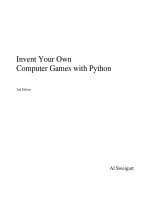Apress wireless java developing with J2ME 2nd edition feb 2003 ISBN 1590590775
Bạn đang xem bản rút gọn của tài liệu. Xem và tải ngay bản đầy đủ của tài liệu tại đây (2.64 MB, 566 trang )
WirelessJavaDevelopingwithJ2ME,
SecondEdition
ISBN:1590590775
byJonathanKnudsen
Apress©2003(384pages)
Thiseditionisupdatedtoincludecoverageof
thenextversionofprogramsformobileJava
devices.MIDP2.0containsmanyexcitingnew
features,suchassoundHTTPSsupport,lotsof
userinterfaceAPIenhancements,aGameAPI,
andmuchmore.
TableofContents
WirelessJavaDevelopingwithJ2ME,SecondEdition
Preface
Chapter1 - Introduction
Chapter2 - BuildingMIDlets
Chapter3 - AllAboutMIDlets
Chapter4 - AlmosttheSameOldStuff
Chapter5 - CreatingaUserInterface
Chapter6 - ListsandForms
Chapter7 - CustomItems
Chapter8 - PersistentStorage
Chapter9 - ConnectingtotheWorld
Chapter10 - ProgrammingaCustomUserInterface
Chapter11 - TheGameAPI
Chapter12 - SoundandMusic
Chapter13 - PerformanceTuning
Chapter14 - ParsingXML
Chapter15 - ProtectingNetworkData
AppendixA - MIDPAPIReference
Index
ListofFigures
ListofTables
ListofListings
ListofSidebars
BackCover
AlthoughJavaisincrediblypopular,thestandard
editionofJavaiswaytoobigandbulkytobuild
applicationsforwirelessdevicessuchasPDAsand
phones.Thus,SunhasreleasedJava2Platform,Micro
Edition(J2ME).J2MEhasthepotentialtobeas
revolutionaryinthewirelessspaceasJavahasbeenin
theserverspace.
WirelessJava:DevelopingwithJ2ME,SecondEditionis
updatedtoincludecoverageofthenextversionof
programsformobileJavadevices.MIDP2.0contains
manyexcitingnewfeatures,suchassoundHTTPS
support,lotsofuserinterfaceAPIenhancements,a
GameAPI,andmuchmore.Also,authorJonathan
Knudsenmakesclearwhatmaterialisnewsoreaders
canstillusethebookforMIDP1.0/CLDC1.0.
AbouttheAuthor
JonathanKnudsenisaJavadeveloperandnoted
authorofseveralbooks,includingWirelessJava:
DevelopingwithJava2,MicroEdition,MobileJava,The
UnofficialGuidetoLEGOMINDSTORMSRobots,
LearningJava,andJava2DGraphics.Jonathanbegan
hisobject-orientedprogrammingcareerinObjective-C
ontheNeXTOS,soonthereaftersufferingthrougha
coupleofpurgatorialyearsinMicrosoft'sVisualC++,
beforegraduatingtoJavain1996.Hehaswritten
extensivelyaboutJavaandLEGOrobots,includingfive
books,amonthlyonlinecolumncalled"Bite-SizeJava,"
andarticlesforJavaWorld,EXE,NZZFolio,andthe
O'ReillyNetwork.Jonathanholdsadegreein
mechanicalengineeringfromPrincetonUniversity.
WirelessJava—DevelopingwithJ2ME,Second
Edition
JONATHANKNUDSEN
Copyright©2003byJonathanKnudsen
Allrightsreserved.Nopartofthisworkmaybereproducedortransmitted
inanyformorbyanymeans,electronicormechanical,including
photocopying,recording,orbyanyinformationstorageorretrieval
system,withoutthepriorwrittenpermissionofthecopyrightownerand
thepublisher.
ISBN(pbk):1-59059-077-5
PrintedandboundintheUnitedStatesofAmerica12345678910
Trademarkednamesmayappearinthisbook.Ratherthanusea
trademarksymbolwitheveryoccurrenceofatrademarkedname,weuse
thenamesonlyinaneditorialfashionandtothebenefitofthetrademark
owner,withnointentionofinfringementofthetrademark.
TechnicalReviewer:MichaelYuan
EditorialDirectors:DanAppleman,GaryCornell,SimonHayes,Martin
Streicher,KarenWatterson,JohnZukowski
ManagingandProductionEditor:GraceWong
CopyEditor:RebeccaRider
Proofreader:GregoryTeague
Compositor:DianaVanWinkle,VanWinkleDesignGroup
Indexer:ValeriePerry
ArtistandCoverDesigner:KurtKrames
ManufacturingManager:TomDebolski
DistributedtothebooktradeintheUnitedStatesbySpringer-VerlagNew
York,Inc.,175FifthAvenue,NewYork,NY,10010andoutsidetheUnited
StatesbySpringer-VerlagGmbH&Co.KG,Tiergartenstr.17,69112
Heidelberg,Germany
IntheUnitedStates,phone1-800-SPRINGER,email
<>,orvisit.
OutsidetheUnitedStates,fax+496221345229,email
<>,orvisit.
Forinformationontranslations,pleasecontactApressdirectlyat2560
NinthStreet,Suite219,Berkeley,CA94710.Phone510-549-5930,fax:
510-549-5939,email<>,orvisit
.
Theinformationinthisbookisdistributedonan"asis"basis,without
warranty.Althougheveryprecautionhasbeentakeninthepreparationof
thiswork,neithertheauthornorApressshallhaveanyliabilitytoany
personorentitywithrespecttoanylossordamagecausedorallegedto
becauseddirectlyorindirectlybytheinformationcontainedinthiswork.
Thesourcecodeforthisbookisavailabletoreadersat
intheDownloadssection.
ToAndrewandElena
Acknowledgments
ThankstoallthefolksatApressforhelpinggetthisbookdone.Thanksto
GaryCornellfortalkingmeintothisbookinthefirstplace.GraceWong
wasmyprojectmanager,ajobIcouldneverhave.Shewasverynice
aboutallofmydelaysandapleasuretoworkwith.Mycopyeditor,
RebeccaRider,putupwithmyformattingidiosyncrasiesandtightened
thebookupalot.ThankstoMichaelYuanforanexcellenttechnical
review.
MyfamilynowhaspermissiontoslapmeupsidetheheadifIever
considertakingonaprojectlikethisagain.Thankstoeveryone—Kristen,
Daphne,Luke,Andy,andElena—forputtingupwithme.
AbouttheAuthor
JonathanKnudsenistheauthorofseveralotherJavabooks,including
LearningJava,Java2DGraphics,andJavaCryptography.Heisalsothe
authorofTheUnofficialGuidetoLEGOMINDSTORMSRobots,but,
sadly,wasunabletoparlaythatsuccessintoafull-timecareer.Jonathan
haswrittennumerousarticlesaboutJavaandafewaboutLEGOrobots
aswell.Heisthefatheroffourchildrenandenjoysbicyclingandplaying
thepiano.Formoreinformation,see />
Preface
Thisbookdescribeshowtoprogrammobiletelephones,pagers,and
othersmalldevicesusingJavatechnology.ItisabouttheMobile
InformationDeviceProfile(MIDP),whichispartofJava2Platform,Micro
Edition(J2ME).Itisconciseandcomplete,describingallofMIDP,aswell
asmovingintoseveraladvancedtopicslikeXMLandcryptography.
ThissecondeditioncoversMIDP2.0,whichincludesmanyexciting
enhancements.Threeentirelynewchaptershavebeenadded,andthe
restofthebookhasbeenmeticulouslyupdated.
WhoareYou?
You'reprobablyreadingthisbookbecauseyou'reexcitedaboutbuilding
wirelessapplicationswithJava.Thisbookisaimedatpeoplewho
alreadyhaveexperienceprogramminginJava.Ataminimum,you
shouldunderstandtheJavaprogramminglanguageandthe
fundamentalsofobject-orientedprogramming.Somechaptersdelveinto
subjectsthatinthemselvescouldoccupyentirebooks.Thesechapters
includesuggestedreadingifyouwanttogetuptospeedonaparticular
subject.
IfyouareunfamiliarwithJava,Isuggestyoureadanintroductorybookor
takeacourse.LearningJava,SecondEdition(O'Reilly2002)isagood
introductiontoJavaforprogrammerswhoarealreadyexperiencedin
anotherlanguagesuchasCorC++.
TheStructureofthisBook
Thisbookisorganizedintofifteenchaptersandoneappendix.Thereare
basicallythreesections.Thefirsttwochaptersareintroductorymaterial.
Chapters3through12providecompletecoverageoftheMIDPAPIs.
Chapters13through15coveradvancedtopics.Thecompletebreakdown
ofchaptersislistedhere:
Chapter1,"Introduction,"providescontextandmotivationforthe
restofthebook.J2MEisexplainedindetail,graduallyzoomingin
toMIDP.
Chapter2,"BuildingMIDlets,"isintendedtobeateaser.It
includesanexampleapplicationthatallowsyoutolookupthe
definitionsofwordsovertheInternetusinganyMIDPdevice.
Alongthewayyou'lllearnalotaboutdevelopingapplicationsfor
theMIDPplatform.
Chapter3,"AllAboutMIDlets,"goesintodetailaboutthelife
cycleandpackagingofMIDPapplications.Itincludesnew
materialontheMIDP2.0securityarchitecture.
Chapter4,"AlmosttheSameOldStuff,"describesthepiecesof
theMIDPAPIthatwillbefamiliartoJavaprogrammers.
Chapter5,"CreatingaUserInterface,"isthefirstofahandfulof
chaptersdevotedtoMIDP'suser-interfacepackages.Itprovides
anoverviewofMIDP'suser-interfacepackageandgoesinto
detailaboutthesimplevisualcomponents.
Chapter6,"ListsandForms,"picksupwhereChapter5leftoff,
describingMIDP'sadvanceduser-interfacecomponents.
Chapter7,"CustomItems,"showshowtocreateyourownform
itemsinMIDP2.0.
Chapter8,"PersistentStorage,"describesMIDP'smechanismfor
storingdata.
Chapter9,"ConnectingtotheWorld,"containsallthejuicydetails
abouthowMIDPapplicationscansendandreceivedataoverthe
Internet.
Chapter10,"ProgrammingaCustomUserInterface,"describes
thelowlevelAPIthatcanbeusedforspecializedapplicationuser
interfaces.
Chapter11,"TheGameAPI,"describesMIDP2.0'snewfeatures
forcreatinggames,includingspritesandtiledlayers.
Chapter12,"SoundandMusic,"isallaboutMIDP2.0'snew
multimediacapabilities.You'lllearnhowtoproducesimpletones
aswellasplaysampledaudiodata.
Chapter13,"PerformanceTuning,"describestechniquesfor
copingwiththelimitedresourcesthatareavailableonsmall
devices.
Chapter14,"ParsingXML,"examinesthespectrumofsmallXML
parsersthatarecurrentlyavailable.Itdescribeshowtoport
parserstoMIDPandbrieflydiscussestheusageinvolvedwith
eachparser.
Chapter15,"ProtectingNetworkData,"discusseshowtoprotect
valuabledataontheinsecureInternet.Itincludestwosample
applicationsthatdemonstratecryptographictechniquesfor
protectingdata.
Finally,anAppendixcontainsacompleteAPIreferenceforthe
classesandinterfacesthatmakeupMIDP.Themethod
signaturesforthepublicAPIofeachclassandinterfacearelisted
forhandyquickreference.Inthissecondedition,theAPI
referenceisflaggedtomakeiteasytoseewhichmethodsare
newinMIDP2.0.
Chapter1:Introduction
Java™2Platform,MicroEdition(J2ME)isthesecondrevolutioninJava's
shorthistory.WhenJavawasintroducedin1995,itlookedlikethefuture
ofcomputingwasinapplets,smallprogramsthatcouldbedownloaded
andrunondemand.AslowInternetforcedappletsoutofthe
mainstream.Java,asaplatform,didnotreallytakeoffuntiltheadventof
servlets,Javaprogramsthatrunonaserver(essentiallyareplacement
forCGI).Javafurtherexpandedintotheserversideofthings,eventually
pickingupthemonikerofJava2Platform,EnterpriseEdition(J2EE).
Thiswasthefirstrevolution,theblitzofserver-sideJava.
Thesecondrevolutionistheexplosionofsmall-deviceJava,andit's
happeningnow.Themarketforsmalldevicesisexpandingrapidly,and
Javaisimportantfortworeasons.First,developerscanwritecodeand
haveitrunondozensofsmallplatforms,withoutchange.Second,Java
hasimportantsafetyfeaturesfordownloadablecode.
UnderstandingJ2ME
J2MEisn'taspecificpieceofsoftwareorspecification.Allitmeansis
Javaforsmalldevices.Smalldevicesrangeinsizefrompagers,mobile
phones,andpersonaldigitalassistants(PDAs),allthewayuptothings
likeset-topboxesthatarejustshyofbeingdesktopPCs.
J2MEisdividedintoconfigurations,profiles,andoptionalAPIs,which
providespecificinformationaboutAPIsanddifferentfamiliesofdevices.
Aconfigurationisdesignedforaspecifickindofdevicebasedonmemory
constraintsandprocessorpower.ItspecifiesaJavaVirtualMachine
(JVM)thatcanbeeasilyportedtodevicessupportingtheconfiguration.It
alsospecifiessomesubsetoftheJava2Platform,StandardEdition
(J2SE)APIsthatwillbeusedontheplatform,aswellasadditionalAPIs
thatmaybenecessary.
Profilesaremorespecificthanconfigurations.Aprofileisbasedona
configurationandaddsAPIsforuserinterface,persistentstorage,and
whateverelseisnecessarytodeveloprunningapplications.
OptionalAPIsdefinespecificadditionalfunctionalitythatmaybeincluded
inaparticularconfiguration.Thewholecaboodle—configuration,profile,
andoptionalAPIs—thatisimplementedonadeviceiscalledastack.For
example,apossiblefuturedevicestackmightbeCLDC/MIDP+Mobile
MediaAPI.Seethesectionlateronplatformstandardizationfor
informationonJSR185,whichwilldefinestandardJ2MEstacks.
Currently,thereareahandfulofconfigurationsandprofiles,asillustrated
inFigure1-1.
Figure1-1:TheJ2MEuniverse
TheJavaCommunityProcess
TheJavaCommunityProcess(JCP)isdesignedtoensurethatJava
technologyisdevelopedaccordingtocommunityconsensus.The
processisdescribedhere:
/>ConfigurationsandprofilesfirstappearintheworldasJava
SpecificationRequests(JSRs).YoucanseealistofcurrentJSRs
here:
/>
Togiveyouaflavorofwhat'shappeningintheJ2MEworld,Table1-1
showssomeoftheconfigurations,profiles,andoptionalAPIsthatare
availableandunderdevelopment.Thisisnotacomprehensivelist;for
moreinformation,checkouttheJCPwebsiteat />Table1-1:J2MEConfigurations,Profiles,andOptionalAPIs
CONFIGURATIONS
JSR NAME
Connected,Limited
URL
30 Device
Configuration
(CLDC)1.0
/>
Connected,Limited
Device
/>139
Configuration
(CLDC)1.1
36
ConnectedDevice
Configuration
/>
PROFILES
JSR NAME
URL
37
MobileInformation />DeviceProfile1.0
118
MobileInformation />DeviceProfile2.0
75 PDAProfile1.0
/>
46 FoundationProfile
/>
129
PersonalBasis
Profile
62 PersonalProfile
/> />
OPTIONALAPIS
JSR NAME
URL
66
RMIOptional
Package
/>
82
JavaAPIsfor
Bluetooth
/>
120
WirelessMessaging />API
135 MobileMediaAPI
/>
179 LocationAPIfor
J2ME
/>
Configurations
AconfigurationspecifiesaJVMandsomesetofcoreAPIsforaspecific
familyofdevices.Currentlytherearetwo:theConnectedDevice
Configuration(CDC)andtheConnected,LimitedDeviceConfiguration
(CLDC).
ConnectedDeviceConfiguration
Aconnecteddevicehas,ataminimum,512KBofread-onlymemory
(ROM),256KBofrandomaccessmemory(RAM),andsomekindof
networkconnection.TheCDCisdesignedfordevicesliketelevisionsettopboxes,carnavigationsystems,andhighendPDAs.TheCDC
specifiesthatafullJVM(asdefinedintheJavaVirtualMachine
Specification,2ndedition)mustbesupported.
TheconfigurationsandprofilesofJ2MEaregenerallydescribedinterms
oftheirmemorycapacity.UsuallyaminimumamountofROMandRAM
isspecified.Forsmalldevices,itmakessensetothinkintermsofvolatile
andnon-volatilememory.Thenon-volatilememoryiscapableofkeeping
itscontentsintactasthedeviceisturnedonandoff.ROMisonetype,
butnon-volatilememorycouldalsobeflashmemoryorbattery-backed
RAM.Volatilememoryisessentiallyworkspaceanddoesnotmaintainits
contentswhenthedeviceisturnedoff.
TheCDCisbeingdevelopedundertheJavaCommunityProcess.For
moreinformationontheCDC,seeA
Linuxreferenceimplementationisavailable.
TheCDCisthebasisofthePersonalProfilestack.ThePersonalProfile
isthenextgenerationofPersonalJava,aJavaapplicationenvironment
thatissimilartoJDK1.1.8.
Connected,LimitedDeviceConfiguration
CLDCistheconfigurationthatinterestsus,becauseitencompasses
mobilephones,pagers,PDAs,andotherdevicesofsimilarsize.CLDCis
aimedatsmallerdevicesthantheCDC.Thenameisalittlemisleading;
really,theCLDCisdesignedforasmalldevicewithalimitednetwork
connection—"LimitedConnectionDeviceConfiguration"mighthavebeen
moreaccurate.
TheCLDCisdesignedfordeviceswith160KBto512KBofmemory
availablefortheJavaplatform.Ifyou'veeverwatchedJ2SEgobbleup
tensofmegabytesofmemoryonyourdesktopcomputer,you'll
appreciatethechallengeofJ2ME.The"limitedconnection"simplyrefers
toanetworkconnectionthatisintermittentandprobablynotveryfast.
(Mostmobiletelephones,forexample,typicallyachievedataratesof
9.6Kbps.)Betweenthesmallscreensize,limitedmemory,andslow
networkconnection,applicationsdesignedintheCLDCspaceshouldbe
verysparingwiththeuseofthenetworkconnection.
TheCLDCisbasedaroundasmallJVMcalledtheKVM.Itsnamecomes
fromthefactthatitisaJVMwhosesizeismeasuredinkilobytesrather
thanmegabytes.WhiletheCLDCisaspecificationsdocument,theKVM
referstoaspecificpieceofsoftware.[1]Becauseofitssmallsize,the
KVMcan'tdoeverythingaJVMdoesintheJ2SEworld.
Nativemethodscannotbeaddedatruntime.Allnative
functionalityisbuiltintotheKVM.
TheKVMonlyincludesasubsetofthestandardbytecodeverifier.
Thismeansthatthetaskofverifyingclassesissplitbetweenthe
CLDCdeviceandsomeexternalmechanism.Thishasserious
securityimplications,aswe'lldiscusslater.
YoucanfindmoreinformationattheCLDChomepage,
Mostdeployeddevices
implementCLDC1.0,butCLDC1.1isalmostcompleteasthisiswritten.
CLDC1.1includesenhancementstoCLDC1.0,includingsupportfor
floating-pointdatatypes.
PlatformStandardization
Giventheprofusionofconfigurations,profiles,andespeciallyoptional
APIs,howdoyouknowwhatAPIsarelikelytobeavailableontypical
devices?Sun'sanswertothisquestionisJSR185
(impressivelytitledJava
TechnologyfortheWirelessIndustry.Thisspecificationaimsto
standardizesoftwarestackstobringcoherencetotheJ2MEworld.
InthenextgenerationofJ2ME,aconceptcalledBuildingBlocksis
supposedtoreplaceconfigurationsandprofiles.ABuildingBlockisjust
somesubsetofaJ2SEAPI.Forexample,oneBuildingBlockmightbe
createdfromasubsetoftheJ2SEjava.iopackage.Conceptually,a
BuildingBlockrepresentsasmallerchunkofinformationthana
configuration.Profiles,then,willbebuiltontopofasetofBuildingBlocks
ratherthanaconfiguration.
ThedefinitionofBuildingBlocksisaJSR,whichisbrieflydescribedhere:
ProgressonJSR68hasbeenextremely
slowsinceitscreationinJune2000.IsuggestkeepingyoureyesonJSR
185instead.
[1]TheKVMwasoriginallypartoftheSpotlesssystem,aSunresearch
project.See />
Profiles
Aprofileislayeredontopofaconfiguration(andsomeday,perhaps,on
BuildingBlocks),addingtheAPIsandspecificationsnecessaryto
developapplicationsforaspecificfamilyofdevices.
CurrentProfiles
SeveraldifferentprofilesarebeingdevelopedundertheJavaCommunity
Process.Table1-1(shownearlier)providesabird's-eyeview.
TheFoundationProfileisaspecificationfordevicesthatcansupporta
richnetworkedJ2MEenvironment.Itdoesnotsupportauserinterface;
otherprofilescanbelayeredontopoftheFoundationProfiletoadduser
interfacesupportandotherfunctionality.
LayeredontopoftheFoundationProfilearethePersonalBasisProfile
andthePersonalProfile.ThecombinationofCDC+FoundationProfile+
PersonalBasisProfile+PersonalProfileisdesignedasthenext
generationofthePersonalJavaapplicationruntimeenvironment(see
Assuch,thePersonalProfile
hasthespecificgoalofbackwardcompatibilitywithpreviousversionsof
PersonalJava.
ThePDAProfile(PDAP),whichisbuiltonCLDC,isdesignedforpalmtop
deviceswithaminimumof512KBcombinedROMandRAM(anda
maximumof16MB).ItsitsmidwaybetweentheMobileInformation
DeviceProfile(MIDP)andthePersonalProfile.Itincludesanapplication
modelbasedonMIDletsbutusesasubsetoftheJ2SEAbstract
WindowingToolkit(AWT)forgraphicuserinterface.AlthoughthePDAP
specificationisnearlyfinished,tomyknowledgenohardware
manufacturerhasannouncedthatitwillbeimplementingPDAP.The
J2MEworldcurrentlyiscoveredbyMIDPonthesmallendandPersonal
Profileonthehigherend.
MobileInformationDeviceProfile
ThefocusofthisbookistheMobileInformationDeviceProfile(MIDP).
Accordingtothespecification,aMobileInformationDevicehasthe
followingcharacteristics:
128KBofnon-volatilememoryfortheMIDPimplementation
32KBofvolatilememoryfortheruntimeheap
8KBofnon-volatilememoryforpersistentdata
Ascreenofatleast96×54pixels
Somecapacityforinput,eitherbykeypad,keyboard,ortouch
screen
Two-waynetworkconnection,possiblyintermittent
TrytoimagineadevicethatmightbeaMIDPdevice:mobiletelephones
andadvancedpagersarerightinthegroove,butentry-levelPDAscould
alsofitthisdescription.
MoreinformationaboutMIDP,includingalinktotheofficialspecification
document,isat />ThisbookcoversbothMIDP1.0andMIDP2.0.MIDP2.0features
numerousenhancements,includingsupportformultimedia,anewgame
userinterfaceAPI,supportforHTTPSconnection,andotherfeatures.It
isfullybackwardcompatiblewithMIDP1.0.Iwillindicatefeaturesthat
arespecifictoMIDP2.0throughouttherestofthebook.
AnatomyofMIDPApplications
TheAPIsavailabletoaMIDPapplicationcomefrompackagesinboth
CLDCandMIDP,asshowninFigure1-2.Packagesmarkedwitha+are
newinCLDC1.1andMIDP2.0.
Figure1-2:MIDPpackages
CLDCdefinesacoreofAPIs,mostlytakenfromtheJ2SEworld.These
includefundamentallanguageclassesinjava.lang,streamclasses
fromjava.io,andsimplecollectionsfromjava.util.CLDCalso
specifiesageneralizednetworkAPIinjavax.microedition.io.
Note AccordingtotheMIDP2.0specification,MIDP2.0willmost
likelybepairedwithCLDC1.1,althoughitiscertainlypossible
forMIDP2.0tobeimplementedatopCLDC1.0.Thefirst
implementationsofMIDP2.0willbepairedwithCLDC1.0,as
theMIDP2.0specificationisfurtheralongintheJava
CommunityProcessthantheCLDC1.1specification.
Optionally,devicevendorsmayalsosupplyJavaAPIstoaccessdevicespecificfeatures.MIDPdevices,then,willtypicallybeabletorunseveral
differentflavorsofapplications.Figure1-3showsamapofthe
possibilities.
Figure1-3:MIDPsoftwarecomponents
Eachdeviceimplementssomekindofoperatingsystem(OS).Native
applicationsrundirectlyonthislayerandrepresenttheworldasitis
today—manydifferentkindsofdevices,eachwithitsownOSandnative
applications.
LayeredontopofthedeviceOSistheCLDC(includingtheKVM)and
theMIDPAPIs.MIDPapplicationsuseonlytheCLDCandMIDPAPIs.
Device-specificJavaapplicationsmayalsouseJavaAPIssuppliedby
thedevicevendor.
AdvantagesofMIDP
Giventhespectrumofconfigurationsandprofiles,whyisthisbookabout
MIDP?First,MIDPcomesatacriticaltime,atimewhenMIDPdevices,
likemobilephones,areanexplodingmarket.Simultaneously,MIDP
devicesareachievingthekindofprocessingpower,memory
consumption,andInternetconnectivitythatmakesthemanattractive
platformfordistributedapplications.MIDP1.0isalreadydeployedon
millionsofhandsetsallovertheworld,andMIDP2.0holdsmuchpromise
forthefuture.
Second,ofcourse,MIDPisthefirstJ2MEprofilethatisreadyforprime
time.Ifyoureadintothenextchapter,youcanwriteMIDPapplications
today.
Portability
TheadvantageofusingJavaoverusingothertoolsforsmalldevice
applicationdevelopmentisportability.Youcouldwritedeviceapplications
withCorC++,buttheresultwouldbespecifictoasingleplatform.An
applicationwrittenusingtheMIDPAPIswillbedirectlyportabletoany
MIDPdevice.
Ifyou'vebeenfollowingJava'sdevelopmentforanytime,thisshould
soundfamiliar.It'sthesame"WriteOnce,RunAnywhere"(WORA)
mantrathatSun'sbeenrepeatingsince1995.Unfortunately,WORAisa
bitofafour-letterwordfordeveloperswhostruggledwithcross-platform
issuesinJDK1.0andJDK1.1(particularlythebrowser
implementations).WhileJava'scross-platformcapabilitiesinJava2are
generallysuccessful,WORAstillhasthetaintofanunfulfilledpromise.
DoesMIDPdeliverpainlesscross-platformfunctionality?Yes.Therewill
alwaysbeplatform-specificbugsinMIDPimplementations,butIbelieve
MIDPworksasadvertisedbecauseitissomuchsmallerthandesktop
Java.Lesscodemeansfewerbugswhenportingtomultipleplatforms.
Mostofthecross-platformincompatibilitiesofJDK1.0andJDK1.1were
causedbythenightmareoftryingtofitdisparatewindowingsystemsinto
theAWT'speer-basedcomponentarchitecture.MIDPhasnothing
approachingthecomplexityofAWT,whichmeansthere'sanexcellent
possibilitythatMIDPapplicationswillseamlesslyrunonmultiple
platformsrightoutofthestartinggate.Furthermore,whiletheJDK1.0
testsuiteonlyincludedafewdozentests,theMIDPcompatibilitytest
suiteincludesseveralthousandtests.
Security
AsecondcompellingreasonforusingJavaforsmalldevicedevelopment
issecurity.Javaiswellknownforitsabilitytosafelyrundownloaded
codelikeapplets.Thisisaperfectfit—it'seasytoimaginenifty
applicationsdynamicallydownloadingtoyourmobilephone.
Butit'snotquitesucharosypicture.Foronething,theKVMusedinthe
CLDConlyimplementsapartialbytecodeverifier,whichmeansthatpart
oftheimportanttaskofbytecodeverificationisperformedofftheMIDP
device.
Second,theCLDCdoesnotallowforapplication-definedclassloaders.
Thismeansthatanykindofdynamicapplicationdeliveryisdependenton
device-specificmechanisms.Asyou'llsee,applicationdeploymentisnot
specificallydefinedintheCLDCorMIDP.
MIDPapplicationsdoofferoneimportantsecuritypromise:theycan
neverescapefromtheconfinesoftheKVM.Thismeansthat,barring
bugs,aMIDPapplicationwillneverbeabletowritetodevicememory
thatdoesn'tbelongtotheKVM.AMIDPapplicationwillnevermessup
anotherapplicationonthesamedeviceorthedeviceOSitself.[2]Thisis
thekillerfeatureofMIDP.Itallowsmanufacturersandcarrierstoopenup
applicationdevelopmenttotheworld,moreorlessfreefromcertification
andverificationprograms,withoutthefearthatroguecoderswillwrite
applicationsthatcrashphones.
InMIDP2.0,MIDletsuitescanbecryptographicallysigned,thenverified
onthedevice,whichgivesuserssomesecurityaboutexecuting
downloadedcode.Anewpermissionsarchitecturealsoallowstheuserto
denyuntrustedcodeaccesstocertainAPIfeatures.Forexample,ifyou
installasuspicious-lookingMIDletsuiteonyourphone,youcanpreventit









